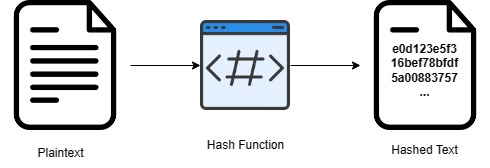Hashing Algorithms: The Quick and Easy Way to Verify Integrity and Authentication
Contents
Hashing Algorithms: The Quick and Easy Way to Verify Integrity and Authentication#
We need an algorithm to encrypt and decrypt information. So, what is an algorithm? They are just arithmetic methods of converting data into an unreadable format. In this blog, we are going to provide an introduction to hashes which are also coined as message digests algorithms (MD).
Encryption algorithms are classified into three types:
Symmetric
Asymmetric
Hashing
Hashing Algorithms#
Here are some characteristics of hashing algorithms and main concepts:
digital footprint: Hashing applies an algorithm to a piece of data to produce a distinctive digital mark. This is also referred to as a hash function. This authentic fingerprint has a fixed size. Every bit of input influences every bit of output.
checksums: If the data is modified in some way, the hash function will return another hash value. These values are also known as secure checksums since they fulfill comparable duties to traditional checksums but are intrinsically more resistant to manipulation.
one-way: The hash function cannot be reverse-engineered, which means that the hash value cannot be used to find the original material that was hashed. Both symmetric and asymmetric algorithms are reversible, which means they can be transformed from cleartext to ciphertext if you have the keys. However, hashing algorithms don’t have a reversible function. As a result, hashing algorithms are often known as one-way hashing functions.
no collision: A solid hashing algorithm will not return identical results from two separate inputs which are also known as a collision. Both outputs should be distinct.

Application of irreversible cryptographic functions#
Message digest algorithms are often used to generate digital signatures, message authentication codes, and encryption keys.
Irreversible encryption algorithms are beneficial for assessing data integrity and authenticity. Because the simplest technique to compare two files is to compute a hash value for each and compare the results.
Passwords are also stored using hashing techniques. When you enter a password into a system, it is usually hashed and only the hashed value is saved. When you try to access a resource and enter your password in future auctions, the operating system validates that the hash value of your password matches the hash value it saved before. If there is a match, you are given access; otherwise, access is denied.
It is difficult to decode passwords that are saved as merely a hash value. Message digests are resilient to attacks. But as always attackers find a way.
Attackers can utilize dictionary and brute-force attacks to make a comparison between the digest value of a text and the stolen hashes. If they are identical, this means that your password has been exposed.
What is a message digest?#
Hash functions provide a straightforward purpose: they accept a possibly long message and create a unique output value based on the message’s content. The message digest is a popular name for this information. It is typically between 128-256 bits in length. Input can be of any length and the output has a fixed value. For any input, the hash function is reasonably simple to compute.
You can create a hash of files or messages and send it to a receiver with the entire message.
You may want to do this for two reasons:
First, the receiver is able to recalculate the hash from the complete message using the same hash algorithm. And the receiver can contrast the revalidated hash value with the sent one to guarantee that the message sent by you and what he or she received is identical.
If there is not a match, it indicates that the message was modified on the road.
Second, a digital signature technique may be implemented using the message digest.
Summary#
Hashing functions are considerably quicker to calculate than conventional cryptographic functions and have numerous strong features. Most encryption algorithms are two-way processes. However, hashing is a one-way, simple method that can both assure integrity and authentication.
In the first part of the blog, we covered what a hash function is, and explained some terms like message digest, checksum, and digital footprint. We also looked at applications of hashing algorithms in the real-world and possible reasons why you want to use them.
See also
Do you want to get practical skills to work in cybersecurity or advance your career? Enrol in MCSI Bootcamps
